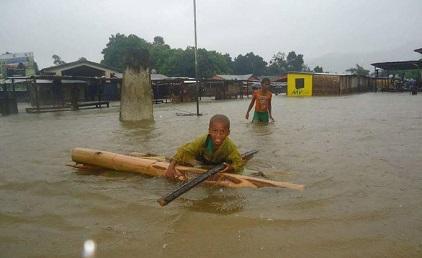
Children make their way through a flooded street in Madagascar during Cyclone Enawo this March (Photo: UNICEF Madagascar)
By Evelyne Karanja
NAIROBI, 7 June 2017 – Struck three months ago by a cyclone that affected 500,000 of its 24 million people, the climate-vulnerable Indian Ocean nation of Madagascar sees early warning and disaster preparedness as fundamental to its future resilience.
Cyclone Enawo, which made landfall in mid-March, claimed 81 lives and injured more than 250 people, according to the National Office for the Management of Risks and Crises, better known as the BNGRC, the acronym for its French-language name the Bureau National de Gestion des Risques et des Catastrophes.
Almost half a million people were affected by Enawo and over 200,000 were displaced. In addition 40,000 houses were destroyed, 3,900 classrooms damaged, 1,300 water points polluted and over a hundred health centers damaged.
Since the cyclone struck, residents have been working to rebuild their lives and livelihoods and get affected communities up and running again.
“The cyclone affected the economy of some of the districts that were directly hit by wind and heavy rains, many households lost their livelihoods and some basic service infrastructures such as roads, and electricity supply were destroyed,” said Mr. Thierry Venty, Executive Secretary of BNGRC.
Enawo, equivalent to a Category 4 hurricane, left in its wake significant damage to housing and agriculture in the northeastern Sava region. Red Cross assessment reports indicated that Antalaha was one of the hardest hit communities, with its port left inaccessible and more than half of the city’s homes destroyed. Half of all housing in Farahalana commune, meanwhile, was left underwater due to flooding by the Lohoko River. In the Analanjirofo region, more than 10,000 people were displaced.
The cyclone was the strongest to strike Madagascar in 13 years. Tropical Cyclone Gafilo hit similar areas in 2004 and resulted in the deaths of 363 people. As a result, Madagascar conducted studies on landfall risks and developed an early warning system. “The results of these studies have really helped us to identify the households which are located in very high risk areas and to improve the way citizens in those areas were alerted and informed of the risks” said Mr. Venty.